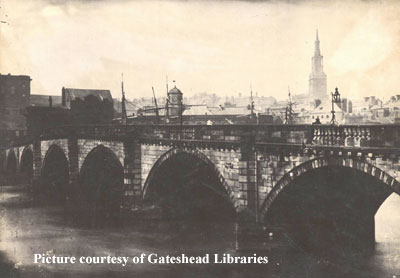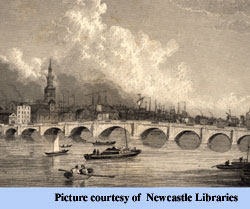
GEORGIAN BRIDGE NEWCASTLE

A new bridge was urgently needed after the collapse of the old medieval bridge but ferries helped fill the gap until a temporary bridge opened in 1772. This utilised part of the remaining structure of the old bridge. The temporary bridge was narrow and had weight restrictions. A new bridge was built on the alignment of the previous bridges and opened in 1781. It was a nine-arched stone bridge designed by Robert Mylne. As with the medieval bridge it had a Newcastle section and a Gateshead section the latter being the three southern arches. The temporary bridge was auctioned and pulled down just before the new bridge opened. Tolls were levied for all users until 1821 and widening took place in 1803.
The Georgian bridge was a major obstruction to navigation on the river and hindered development upstream or 'above bridge' as industrialisation of the Tyne increased. Keels were necessary to move coal and other cargoes down river to ships 'below bridge' with consequent increased costs and time delays. The bridge was at a low level and there were steep climbs from the river banks. These problems were later solved with the building of first the High Level and then the Swing Bridge.
- Constructed - 1774-1781
- Type - arch, stone 9 arches.
- Position - on site of the present Swing Bridge.
- Grid Ref - NZ 253 637

